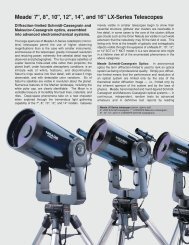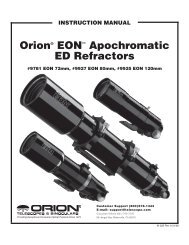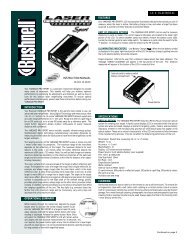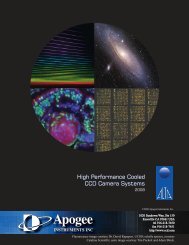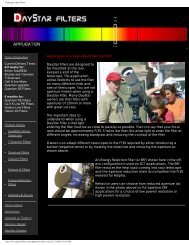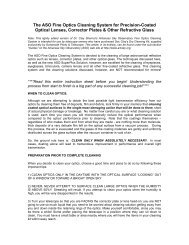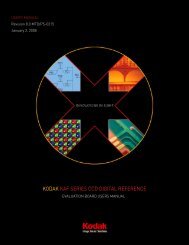Leica Sport Optics
Leica Sport Optics
Leica Sport Optics
Create successful ePaper yourself
Turn your PDF publications into a flip-book with our unique Google optimized e-Paper software.
Natural experience in the tidelands The North Sea mud<br />
flats have a particular significance as a resting place for migratory<br />
birds. Here the birds store their reserves of fat, moult, and recover<br />
from the stress of flying the thousands of kilometers on the first stage<br />
of their journey. An attraction – also for birdwatchers.<br />
The swarm circles once more to lose in<br />
height, then the nun geese glide past us<br />
in sinking flight against the cold east<br />
wind. The light of the fall sun illuminates<br />
the white stomachs of the large birds,<br />
contrasting with black necks adjacent<br />
to white faces. The swarm is a good 200<br />
birds strong. With excited barking cries<br />
the geese land on the meadow, where<br />
on the ground they appear surprisingly<br />
small. They join the other nun geese,<br />
which we have been watching for some<br />
time with our Televid spotting scopes.<br />
We’re standing on the observation tower<br />
on the road between St. Peter-Ording<br />
and the Eider Dam on the west coast of<br />
Schleswig-Holstein. Before us stretch<br />
the Kating mud flats and behind us lie<br />
the North Sea mud flats. Mud flats on<br />
both sides of the dam ? The apparent<br />
contradiction is quickly cleared up when<br />
one learns that the Kating mud flats –<br />
formed by the tides in earlier times –<br />
since about 30 years ago are mud flats<br />
in name only and now consist of grassland,<br />
swamps, fields, ditches, and even<br />
woods. 1,200 hectares (2,965 acres)<br />
were removed from the influence of<br />
the tides when the Eider Dam was built<br />
as a protection against storm floods.<br />
Thus the ecologically valuable mud flats<br />
were destroyed. However, on the other<br />
side of the dam equally valuable habitats<br />
were created – actually, many more than<br />
were planned. This was due to the fact<br />
that the ambitious goals for tourism of<br />
the land planners were never carried out<br />
for a number of reasons. So instead of<br />
having camping grounds, vacation villages,<br />
and trail riding, kibitzers, blacktailed<br />
godwits, gray geese, and many<br />
other swamp birds settled here. Soon<br />
after the troop of geese land, the commotion<br />
dies down. Families come to-<br />
gether again and grass begins to be<br />
assiduously “mowed down”. Geese are<br />
almost entirely grass eaters, who in their<br />
winter quarters have nothing more to<br />
do than eat grass and digest. The nun<br />
geese already have a very long stretch<br />
behind them. Now in October up to<br />
20,000 of the beautiful Nordic geese<br />
congregate here in the Kating mud flats<br />
and surrounding areas. However, with<br />
only a few exceptions, they don’t breed<br />
here, but rather in arctic Siberia.<br />
A long look around from a 13-meterhigh<br />
(42-foot-high) tower shows us many<br />
more birds. Wigeons graze like the geese<br />
on the meadows. Gulls are everywhere<br />
in the air. From the mud flats we hear<br />
the shrill whistling of the oystercatcher,<br />
and at the edge of the pool in front of us<br />
dunlins walk with mincing steps. In the<br />
meadows we discover curlews and a<br />
small troop of kibitzers, in addition to a<br />
number of ducks on the Kating tideway,<br />
meadow pipits, wagtails … The plethora<br />
of birds shows impressively the significance<br />
of this area for birds migrating<br />
on the eastern Atlantic migration path,<br />
which connects the breeding grounds in<br />
Greenland and Siberia with winter quarters<br />
all the way down to South Africa.<br />
The North Sea mud flats have a special<br />
significance as a place to rest and fill up.<br />
Here the birds store their reserves of<br />
fat, moult, and recover from the stress<br />
of flying the thousands of kilometers<br />
on the first stage of the journey. Not for<br />
all birds is the journey over when they<br />
reach the North Sea mud flats as it is for<br />
the nun geese. Many fly much further to<br />
the south. The proximity of the Kating<br />
mud flats to the coast, to the Eider river,<br />
and the North Sea marshes makes it<br />
attractive to migratory birds. At high tide,<br />
the birds search for food in the embankments<br />
of the Kating mud flats or wait for<br />
the next ebb tide. In addition to the open<br />
flats, further bird habitats also exist in<br />
the Kating mud flats. This is the reason<br />
why the Kating mud flats have become<br />
one of the “hot spots” of the bird watching<br />
scene. This area becomes a subject<br />
of conversation again and again due to<br />
the observation of exceptional rarities.<br />
Sometimes the birdwatchers stand like<br />
regular snakes to catch a glimpse of<br />
terek sandpipers, zitting cisticolas,<br />
white-winged sea swallows, dwarf<br />
flamingos, or white-tailed kibitzers.<br />
This little paradise for bird watchers,<br />
“birders,” ornithologists, and of course<br />
friends of nature in general, is looked<br />
after by the Katinger Watt NABU Nature<br />
Center, with headquarters in the Lina<br />
Haenle house on the old Eider Dam.<br />
Here Sibylle Stromberg, manager of this<br />
facility of the Nature Protection Alliance<br />
of Germany (NABU), and biologist Holger<br />
Bruns organize guided tours, seminars,<br />
excursions, exhibitions, and not least,<br />
oversee the care and management of<br />
3,000 hectares (7,413 acres) of protected<br />
areas. The Katinger Watt NABU Nature<br />
Center has been in existence since 1991<br />
and by now attracts every year approximately<br />
13,000 visitors, who linger here<br />
for a surprisingly long time. Some even<br />
stay for days. Next to the house, the<br />
nature information area stretches out<br />
for 200 hectares (494 acres) and includes<br />
an observation tower and two blinds<br />
(hides) built in the British style. From<br />
here even beginners in bird lore can make<br />
impressive observations and admire<br />
gray geese, redshanks, or kibitzers in<br />
very close proximity. In addition, excursions<br />
led by NABU teams visit the nature<br />
reserve areas of Green Island and Olversum<br />
Foreshore. For all such observations<br />
both beginners and occasional observers<br />
are well-outfitted with <strong>Leica</strong> binoculars<br />
or even a Televid spotting scope.<br />
The picture of the Kating mud flats<br />
would not be complete if we did not<br />
mention two events that have made<br />
waves throughout Germany. In May,<br />
the Nature Experience Days, including<br />
an exhibit of binoculars and spotting<br />
scopes, receive a great deal of attention.<br />
About 1,000 visitors rush to try out the<br />
newest high-quality optics and other bird<br />
watching gear and of course to watch<br />
every throng of birds during this peak<br />
migration time. A breath of “birdfair”<br />
wafts over the marsh, and the positive<br />
effect of the lectures, tours, and films,<br />
together with the familiar, relaxed<br />
atmosphere, for ecological education<br />
and communication between nature<br />
and bird lovers, cannot be too highly<br />
estimated. The “West Coast Bird Watch”<br />
takes place at the same time as the<br />
“European BirdWatch” during the first<br />
weekend of October – again during the<br />
best migration time. The Katinger Watt<br />
NABU Nature Center also contributes to<br />
this multi-regional event and thereby<br />
speaks to hundreds of bird watchers.<br />
Thomas Griesohn-Pflieger<br />
8 / 9<br />
<strong>Leica</strong> and Katinger Watt<br />
<strong>Leica</strong> Camera AG has for many years<br />
supported the important work of the<br />
Katinger Watt NABU Nature Center toward<br />
nature clarification and education<br />
and also helps with binoculars and spotting<br />
scopes. In this way visitors can enjoy<br />
nature with top-quality optics and discover<br />
many small details that would perhaps<br />
be missed with the naked eye or<br />
with lower-quality optics. So <strong>Leica</strong> makes<br />
a contribution to nature conservation<br />
and likewise to the enjoyment of nature.<br />
www.nabu-kattinger-watt.de





